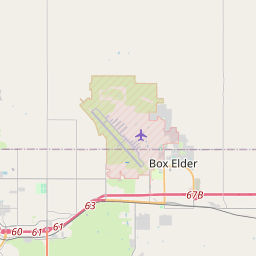Pioneers and Native Americans
Historical marker location:
1510 W Omaha St, Rapid City, South Dakota
( Marker can be reached from West Omaha Street just east of Canal Street, on the right when traveling west.)













© OpenStreetMap contributors
[Founders Park Plaza]
Loading...
Searching for other points of interest within 3 miles of this location.The Badlands National Park, located in southwestern South Dakota, is home to one of the world's richest fossil beds, containing the remains of ancient horses, rhinoceroses, and other prehistoric animals.
About Pennington County
Pennington County Timeline
Pennington County, South Dakota, has a rich and diverse history that stretches back thousands of years. The region was originally inhabited by various Native American tribes, including the Lakota Sioux, who relied on the abundant natural resources for their livelihoods. The area later became part of the Dakota Territory, established in 1861.
In the late 19th century, the discovery of gold in the Black Hills region sparked a rush of settlers to Pennington County. This led to conflicts between the Native Americans and the newcomers, culminating in the Battle of Wounded Knee in 1890, which marked the end of armed Native American resistance in the area. The mining industry continued to flourish, attracting people from all over the country, and the city of Rapid City was founded in 1876 to support this growing population.
During both World Wars, Pennington County played a significant role in supporting the war efforts. The area was used as a training ground for soldiers, and Ellsworth Air Force Base was established near Rapid City in 1942. The base played a crucial role in the Cold War, housing nuclear-armed B-52 bombers. Today, Ellsworth Air Force Base remains an important military installation.
In recent years, Pennington County has experienced growth in sectors such as tourism and education. The Black Hills attract visitors from around the world who come to see iconic landmarks like Mount Rushmore and Crazy Horse Memorial. Rapid City has also become a hub for higher education, with institutions like South Dakota School of Mines and Technology promoting research and innovation in various fields. Overall, Pennington County's history is shaped by the blending of Native American heritage, mining booms, military activity, and modern advancements.
In the late 19th century, the discovery of gold in the Black Hills region sparked a rush of settlers to Pennington County. This led to conflicts between the Native Americans and the newcomers, culminating in the Battle of Wounded Knee in 1890, which marked the end of armed Native American resistance in the area. The mining industry continued to flourish, attracting people from all over the country, and the city of Rapid City was founded in 1876 to support this growing population.
During both World Wars, Pennington County played a significant role in supporting the war efforts. The area was used as a training ground for soldiers, and Ellsworth Air Force Base was established near Rapid City in 1942. The base played a crucial role in the Cold War, housing nuclear-armed B-52 bombers. Today, Ellsworth Air Force Base remains an important military installation.
In recent years, Pennington County has experienced growth in sectors such as tourism and education. The Black Hills attract visitors from around the world who come to see iconic landmarks like Mount Rushmore and Crazy Horse Memorial. Rapid City has also become a hub for higher education, with institutions like South Dakota School of Mines and Technology promoting research and innovation in various fields. Overall, Pennington County's history is shaped by the blending of Native American heritage, mining booms, military activity, and modern advancements.
Pennington County Timeline
This timeline provides a condensed summary of the historical journey of Pennington County, South Dakota.
- 1875: Pennington County is established as part of the Dakota Territory.
- 1890: Rapid City is founded as the county seat.
- 1893: The Black Hills and Badlands Forest Reserve is established, encompassing a large portion of Pennington County.
- 1911: The Rapid City Weather Bureau Station is opened in Pennington County.
- 1941-1945: During World War II, the Rapid City Army Air Base is constructed, bringing significant military presence to the county.
- 1972: A disastrous flood hits Rapid City, causing significant damage and loss of life.
- 1980: Mount Rushmore National Memorial, located in Pennington County, is added to the National Register of Historic Places.
- 1992: The Black Hills National Forest, including parts of Pennington County, is designated as a National Scenic Byway.
- 2010: Rapid City's population exceeds 70,000, making it the second-largest city in South Dakota.